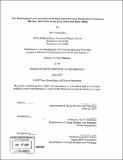The development and function of an affordable housing production ecosystem : Harlem, Hew York in the late 1990s and early 2000s
Author(s)
Dookchitra, Ben
DownloadFull printable version (6.925Mb)
Other Contributors
Massachusetts Institute of Technology. Dept. of Urban Studies and Planning.
Advisor
Karl F. Seidman.
Terms of use
Metadata
Show full item recordAbstract
In late 1990s and early 2000s Harlem, an affordable housing production "ecosystem" comprised of elected officials, city planners, civic advocates, builders, and financial institutions at the local, state, and national level supported a reliable, systematic pipeline of new affordable housing construction. The output of this pipeline included Harlem's first midrise affordable housing construction in thirty years in the late 1990s and, by the early 2000s, over 15,000 units of affordable housing construction starts per year. This thesis seeks to describe the creation and operation of this affordable housing production ecosystem within a framework of "push," "pull," and "safety net" factors influencing the allocation of capital and resources. "Push" factors consisted of the Community Reinvestment Act and Home Mortgage Disclosure Act, the evolution of which led private investment into low-income and minority communities such as Harlem. "Pull" factors included the deeply-experienced, closely-knit network of affordable housing professionals working in Harlem that had the skills and influence to execute projects; and a long-term, comprehensive community development framework, spearheaded by the public sector, that organized affordable housing efforts across the public, non-profit, and private sectors. (cont.) "Safety net" factors included local subsidies, housing finance innovations, and the emergence of secondary markets, all of which decreased the risk and uncertainty of investment in pioneering Harlem affordable housing projects. This thesis will also assess the ecosystem in practice by examining key representative projects: Maple Plaza and Maple Court; The Renaissance; and Madison Park, Madison Court, and Madison Plaza. These projects roughly represent an initial stage, fully-formed stage, and further evolved stage of the affordable housing production ecosystem at work. Looking ahead, this thesis seeks to identify and assess future challenges that the ecosystem must address as the banking industry evolves, local market and policy conditions change, and secondary markets grow larger and more complex. Lastly, this thesis seeks to draw insights from the Harlem experience for affordable housing practitioners and for communities seeking to create their own affordable housing production ecosystems.
Description
Thesis (M.C.P.)--Massachusetts Institute of Technology, Dept. of Urban Studies and Planning, 2007. Includes bibliographical references (p. 112-116).
Date issued
2007Department
Massachusetts Institute of Technology. Department of Urban Studies and PlanningPublisher
Massachusetts Institute of Technology
Keywords
Urban Studies and Planning.